For all of you who are curious or thinking of investing money in coin collecting, know that the 1946 Walking Liberty Half-Dollar is a perfect coin to start your collection.
It can be overwhelming for someone new to coin collecting to learn all the details you need to know to understand the value of old coins.
That is why we bring you this guide, which will give you all the basics on how to evaluate a coin and how to identify the price of a 1946 Walking Liberty Half-Dollar coin.
1946 Walking Liberty Half-Dollar Details
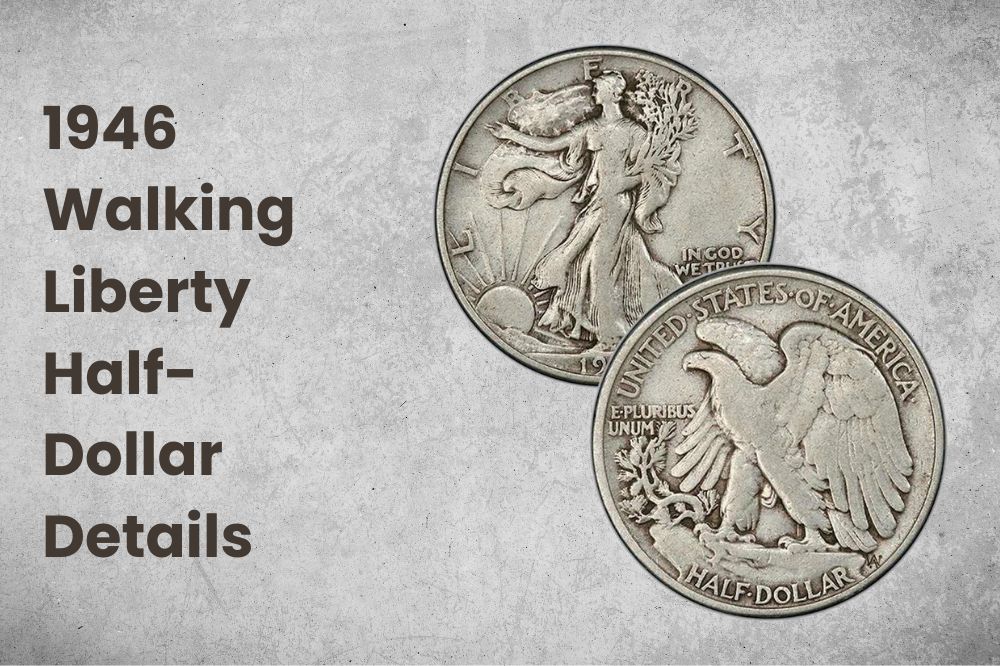
- Category: Walking Liberty Half Dollars (1916-1947)
- Mint: Philadelphia, Denver, San Francisco
- Mintage: 17,993,000
- Obverse Designer: Adolph A. Weinman
- Reverse Designer: Adolph A. Weinman
- Composition: Silver
- Fineness: 0.9
- Weight: 12.5g
- ASW: 0.3617oz
- Melt Value: $7.89 (2/21/2023)
- Diameter: 30.6mm
- Edge: Reeded
The 1946 Half dollar is made with 90% silver and 10% copper. It is also considered one of the most beautiful coins ever minted by the United States Mint.
It also has a minting error in one of its series and that makes certain copies of this coin very valuable and sought after in the collectors’ market.
The Obverse
The obverse bears the image of the well-known Lady Liberty, walking towards the rising sun. Lady Liberty walks wrapped in the United States of America flag and holds an olive and oak branch in her hand, which represents civil glory and military glory.
The word LIBERTY surrounds the coin in the upper part and in the lower part the year 1946 is minted. On the lower right side of the coin are also the letters that say: IN GOD WE TRUST.
It is said that the model used for Lady Liberty was Elsie Stevens, the same one used for the Mercury dime but the story could never be confirmed.
However Holy, Elsie’s daughter declared in 1966 that her mother had confessed to having been the model for the two coins.
The Reverse
The reverse features an American eagle, the most distinctive symbol of the United States.
For them, the eagle has always meant strength and intelligence. This coin was highly praised for the figure of the eagle, which, unlike other versions of coins, here a position of strength and power is achieved, turning this image into a classic within the American nation.
The eagle stands in a posture of power, its talons on a pine branch jutting out of a cliff. It has the word HALF DOLLAR in the bottom center and the word UNITED STATES OF AMERICA surrounds the top of the coin.
In the bottom left is the word “E PLURIBUS UNUM”, the classic phrase written on many American coins, which means: one of many.
The mintmarks on this coin are very small, so you should check the coin carefully. They are present very overlappingly, on the bottom left of the coin, just below the cliff in the image.
1946 Walking Liberty Half-Dollar Value Chart
| Quality | 1946 Walking Liberty Half-Dollar | San Francisco 1946 Walking Liberty Half-Dollar | Denver 1946 Walking Liberty Half-Dollar | 1946 Walking Liberty Half-Dollar DDR |
| Good | $15 | $15 | $15 | $23 |
| Very Good | $17 | $17 | $17 | $28 |
| Fine | $19 | $19 | $19 | $32 |
| Very Fine | $21 | $21 | $21 | $46 |
| Extra Fine | $21 | $21 | $25 | $78 |
| AU | $23 | $28 | $40 | $144 |
| MS 60 | $42 | $49 | $52 | $318 |
| MS 63 | $56 | $67 | $71 | $612 |
1946 Walking Liberty Half-Dollar Value and Varieties Guides
Before beginning to describe the different types of coins minted in 1946, we must make a precise explanation regarding the table of values that we have shown.
A large number of 1946 half dollars are known to have a minting error. This error is called Double Dice Reverse (DDR) and is found on the reverse of the coin.
You can tell that you have a DDR coin by looking at the repetition of the phrase “E PLURIBUS UNUM” and the right wing of the American eagle.
Consequently, the mint has established a special category of coins with this error, which can sell for a large sum of money.
Outside of that mistake, the 1946 half-dollar was minted in Philadelphia, San Francisco, and Denver and this is the way to identify each of the coins.
1946 Philadelphia Walking Liberty Half Dollars
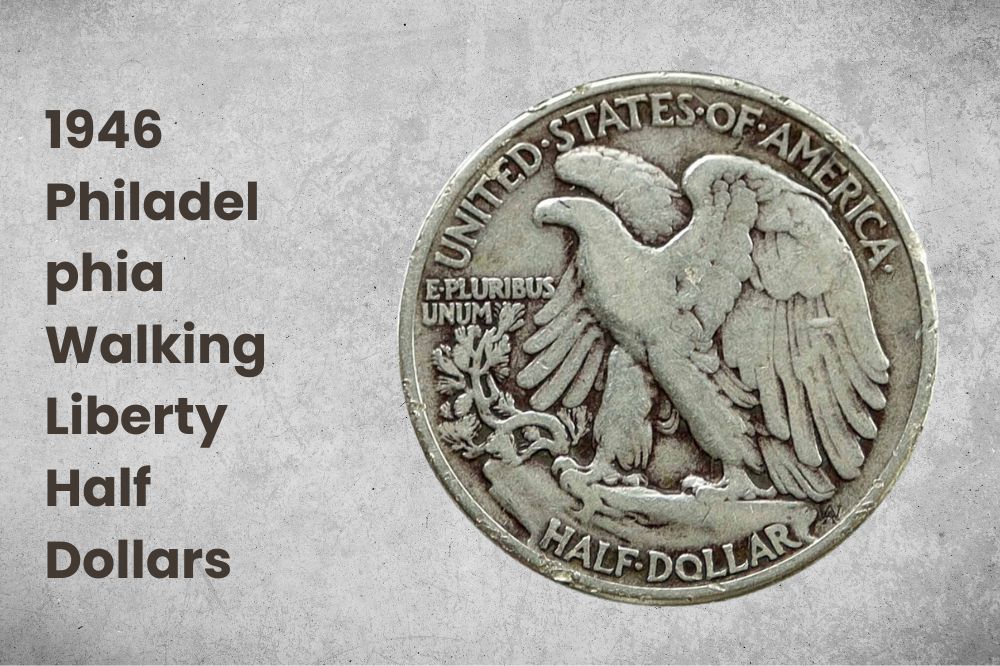
- Category: Walking Liberty Half Dollars (1916-1947)
- Mint: Philadelphia
- Mintage: 12,118,000
- Obverse Designer: Adolph A. Weinman
- Reverse Designer: Adolph A. Weinman
- Composition: Silver
- Fineness: 0.9
- Weight: 12.5g
- ASW: 0.3617oz
- Melt Value: $7.89 (2/21/2023)
- Diameter: 30.6mm
- Edge: Reeded
Philadelphia was the mint where the most copies were printed in 1946. Interestingly, it is also the mint that produced the most DDR errors. Coins minted in Philadelphia do not have a mint mark.
The cheapest coins of this class can cost you about 30 dollars in normal conditions, but those that are considered gem quality have been sold for 20,000 or 30,000 dollars.
1946 San Francisco Walking Liberty Half Dollars
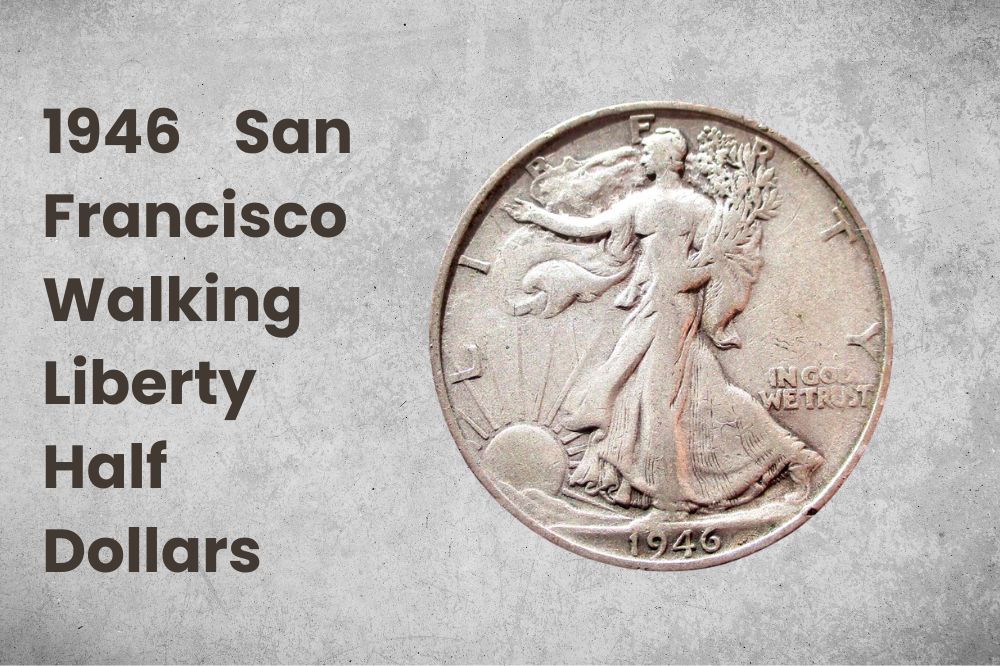
- Category: Walking Liberty Half Dollars (1916-1947)
- Mint: San Francisco
- Mintage: 3,724,000
- Obverse Designer: Adolph A. Weinman
- Reverse Designer: Adolph A. Weinman
- Composition: Silver
- Fineness: 0.9
- Weight: 12.5g
- ASW: 0.3617oz
- Melt Value: $7.89 (2/21/2023)
- Diameter: 30.6mm
- Edge: Reeded
San Francisco coins rank second in production, with over 3 million coins. A coin in circulation can cost up to 50 dollars. But coins that have not been in circulation can go as high as $150 or more. The mint mark is the letter “S ” on the reverse of the coin.
Gem-quality coins have been known to sell for four or five figures. In 2021, an MS 67 copy was sold for $38,400.
1946 Denver Walking Liberty Half Dollars
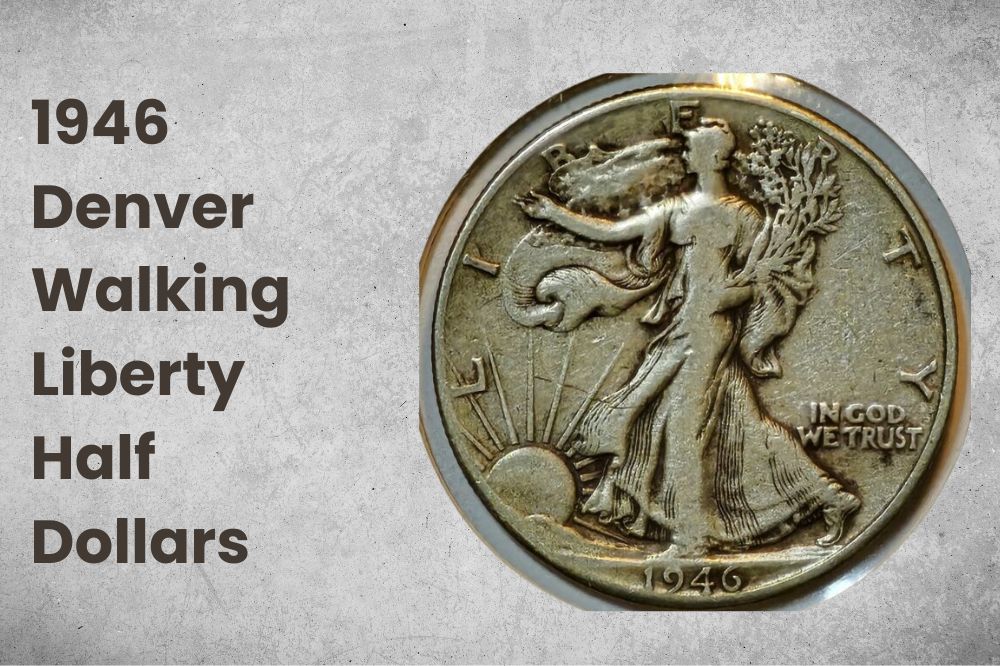
- Category: Walking Liberty Half Dollars (1916-1947)
- Mint: Denver
- Mintage: 2,151,000
- Obverse Designer: Adolph A. Weinman
- Reverse Designer: Adolph A. Weinman
- Composition: Silver
- Fineness: 0.9
- Weight: 12.5g
- ASW: 0.3617oz
- Melt Value: $7.89 (2/21/2023)
- Diameter: 30.6mm
- Edge: Reeded
The Denver mint minted just over two million coins. Although the number of its production is small, there are many examples left, making the price for one of these coins, not a big deal. The mint mark is the letter “D ” on the reverse of the coin.
You can usually buy a good quality one for around 10 dollars and the finest specimens can cost at least a thousand dollars.
The most expensive coin of this type ever sold was a quality MS 67 at $31,220. It was the highest sales record at auction, but it typically sells for between $10,000 and $15,000.
1946 Walking Liberty Half-Dollar History
The half dollars, also nicknamed “Walkers” for the figure of Lady Liberty walking towards the rising sun, were minted from 1916 to 1947, making the 1946 coin the penultimate in its series.
By 1915 the mint had a new manager, Robert Woolley, who thought it appropriate to change the design of several coins that were more than 25 years old.
A contest sponsored by the mint was held and Adolph A. Weinman was the winner. Weinman was a very talented sculptor who designed not only the half-dollar coin but also the Mercury Dime.
Both the Mercury Dime and the Liberty Walker are considered among the most beautiful coins in American history. Some specialists say that they would even enter among the best in the world.
However, the beauty of this coin did not prevent it from being affected by various technical problems. The initial design of the coin did not fit well. The word LIBERTY was located in another space and the coinage was not clear.
Robert Woolley had to have it redesigned but he was never able to oversee any changes, as he resigned and went on to work on President Wilson’s re-election.
Friedrich Johannes was Woolley’s replacement and he had to face more problems regarding the coinage. The Walking Liberty coin and Mercury Dimes had a problem being recognized by vending machines.
A beaded border was added to the coin to correct this problem. In order to avoid any other problems during the minting process, Lady Liberty’s size was also reduced.
Problems kept cropping up until Adam Joyce, one of the mint’s supervisors, adjusted the force of the vises and lowered the relief of the design to fix it.
Despite joint efforts to fix the coin’s design, the makers noticed that in many mints the image did not come out clearly.
That is why to this day you can find uncirculated coins that look just like the ones that were heavily used. The 1946 coins were weakly minted and many of them may be in mint condition but very faded in their designs.
1946 Walking Liberty Half-Dollar Grading
For those who are not familiar with the price of coins in the collectors’ market, all this information can be very overwhelming. So we leave you with a video in which you can find information on how to price a coin of this type.
List of 1946 Walking Liberty Half-Dollar Errors
1946 Doubled Die Reverse Walking Liberty Half Dollars
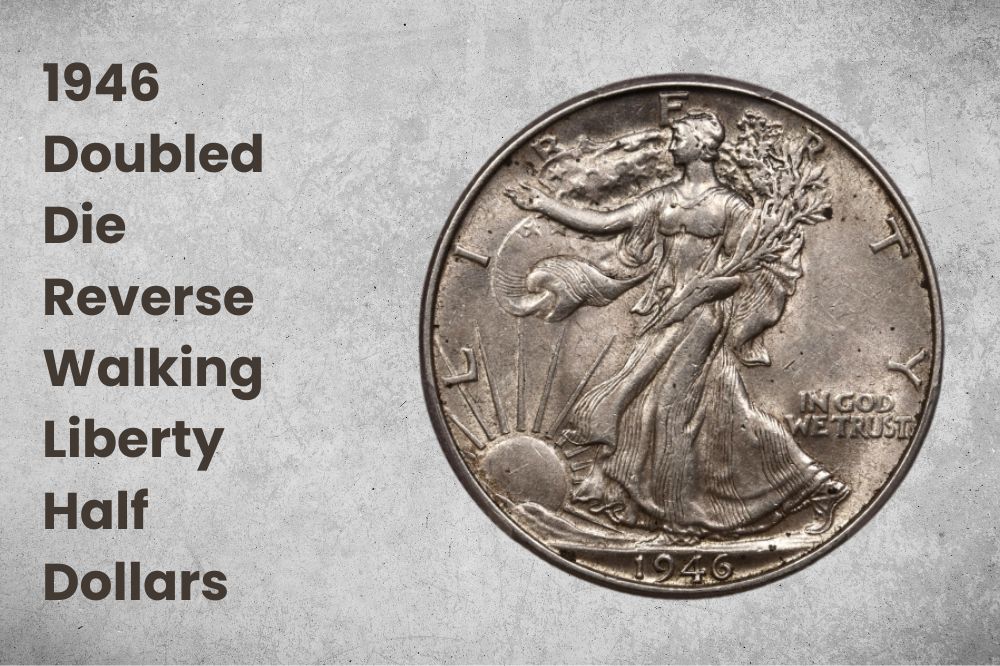
As we mentioned earlier, the Double Dice Reverse is a well-known error featured by several 1946 half dollars.
The problem of its highly ornate design caused the minting houses to have problems legibly minting some parts of the coin.
Coins in this category have two errors on the reverse. The first is the duplicity of the phrase “E PLURIBUS UNUM” and the duplicity on the right wing of the American eagle.
This error is widely known and accepted by the mint, making this type of coin one of the most sought-after objects by collectors.
In other words, if you are lucky enough to have a duplicate image on the reverse of your 1946 coin, the coin may sell for as many as five figures if the coin is in excellent condition. To complement the information, we leave you a video to know more about this coin and its errors.
1946 Walking Liberty Half-Dollar FAQ
How much is a 1946 Walking Liberty Half Dollar Worth?
The 1946 Walking Liberty are worth anywhere from $10 to $35 each depending on how well preserved they are.
But that does not mean that you do not have the opportunity to earn some money with this coin, since the copies in perfect condition have been sold at public auctions for up to 30 thousand dollars and currently you can find the best copies in the open market for 20 thousand dollars.
Are there 1946 Walking Liberty proof coins?
No. Even though the coin had been minted for more than 30 years, none of its three minting houses had proof prints in 1946.
What are the signs I should look for to know that a Walking Liberty half-dollar is real?
The obverse of the coin is very detailed and that is why they had many problems when printing them. To identify a true coin, you must see the horizontal lines that form very subtly on Lady Liberty’s body.
The diagonal lines that are located at the height of Lady Liberty’s hind foot also give a clue of veracity. These two points are essential to identify if you have a real coin or if it is a copy.
Where do I find the mint mark on a Walking Liberty half-dollar?
This coin has a very small mintmark and can be a problem finding it if you don’t have good eyesight. The dry mark never changed its place and was always located on the reverse of the coin, in the lower left part.
It is exactly at the height of the rock tip that the branch and the eagle are supported. If you can’t find a dry brand it’s because it was minted in Philadelphia.
Also remember that coins with the DDR error will generally not have a mint mark, as most errors were made at the Philadelphia mint.
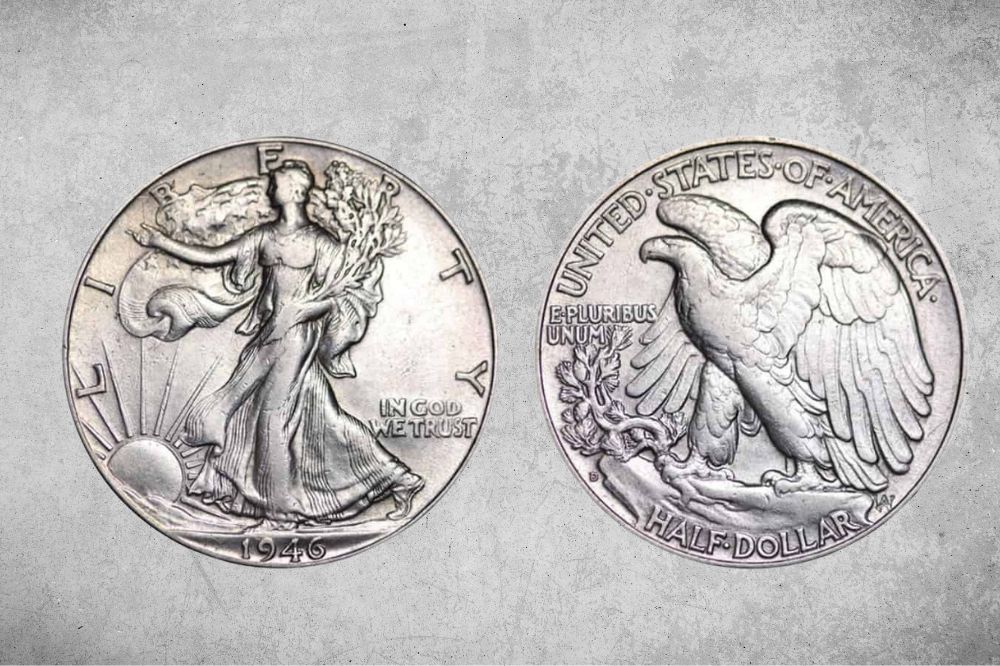
Are A over W the Scultoror’s Adolf Weinman’s Initals on ALL coins? As far as the DDR we don’t have it on “E Plurus…” But DO have it on Right Wing.